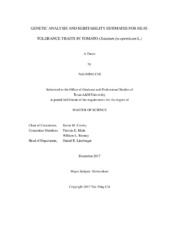| dc.description.abstract | High temperature is a major limiting factor for tomato production in subtropical and tropical regions. Traditional breeding of heat tolerant crops is mainly based on phenotypic analysis and selection of individuals or lines with higher yield. Most abiotic stress tolerance traits are polygenic and inherited in a complex fashion. Studying correlation and the genetic control for heat-tolerance traits under high temperature stress facilitates tomato breeding for heat tolerance. In the first experiment, the main gene effects for heat-tolerance traits were determined by generation mean analysis of six genetic generations of two crosses ‘Freshmarket 9’ x ‘Black Sea Man’ and T215VR x ‘Manyel’ in two locations, College Station. TX and Waller, TX. For ‘Freshmarket 9’ x ‘Black Sea Man’, dominance effects were significant for all traits except pollen viability in Waller. For T215VR x ‘Manyel’, significant additive effects were found in all traits, with pollen viability showing significance in both additive and dominance effects in College Station. In Waller, significant dominance effects were found in fruit number per cluster and fruit set. Narrow-sense heritability estimates for the heat-tolerance traits were low to moderate in both locations. The low narrow-sense heritability for most traits implied that single plant selection in the F2 will not be effective, and that alternative approaches such as mass or recurrent selection should be considered in early generations.
In the second experiment, Design II and combining ability analysis revealed that both additive and dominance gene action contributes to the expression of heat-tolerance traits with additive effects being the primary role in the expression of pollen viability, days to flower and flower number per cluster, and with dominance effects being predominant in the expression of days to first fruit, fruit number per cluster, fruit set and yield. The parent lines ‘Homestead’, T214, and ‘Freshmarket 9’ were identified as good general combiners and ‘Homestead’ x ‘Freshmarket 9’ as the most favorable hybrid combination which can be used in developing heat tolerant hybrids. The findings of this study should be able to provide information to breeders for parent selection and hybrid development in tomato breeding for heat tolerance. | en |


